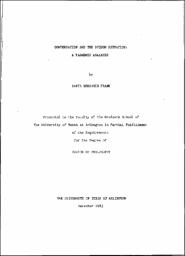
ATTENTION: The works hosted here are being migrated to a new repository that will consolidate resources, improve discoverability, and better show UTA's research impact on the global community. We will update authors as the migration progresses. Please see MavMatrix for more information.
Show simple item record
| dc.contributor.author | Frank, David Benjamin | |
| dc.date.accessioned | 2020-10-09T21:05:15Z | |
| dc.date.available | 2020-10-09T21:05:15Z | |
| dc.date.issued | 1983-12 | |
| dc.identifier.uri | http://hdl.handle.net/10106/29505 | |
| dc.description.abstract | Until recently, conversation, considered even now by some to be outside the scope of linguistics, has been neglected in linguistic research. Chapter One of this dissertation argues that the popular distinction between 'theories of language structure' and 'theories of language use' might be abandoned in order to allow a more integrated study of language and a clearer understanding of the nature of language in the context of human life. To forward such an integrated study, a theoretical model on which to base the analysis of both conversation structure and other linguistic structures must be developed. The tagmemic model, developed by Kenneth Pike, Robert Longacre, and others, allows the same set of procedures to be used to analyze paragraphs, texts, and conversations as is used in analyzing words, phrases, and clauses. Chapter Two presents this model. Consideration of the context of conversation is necessary for the adequate analysis of the conversation itself. Chapter Three illustrates the description of a speech situation using a revision of Pike's (1967) tagmemic methodology developed for the analysis of 'behavioremes'. The proposed revisions give attention to the three hierarchically structured main components of the speech situation: the physical world; the events; and, the cultural matrix. One particular behavioreme (speech situation) analyzed in Chapter Three is a wedding ceremony. Chapter Four focuses on conversation as a particular complex of events in the behavioreme. Conversational exchanges such as question-answer and proposal-compliance are analyzed in terms of the tagmemic slot-filler and form-function distinctions. Several conversations are analyzed in this fashion. Although the focus in Chapter Four is on the exchange level, the relations among conversational exchanges and other levels of structure are pointed to. Chapter Five summarizes the conclusions of the study. Appendices One and Two present much of the data analyzed in Chapters Three and Four respectively. Two main goals of this dissertation have been (1) to demonstrate some of the structural patterns in conversation and the speech situation, and (2) to develop a model that facilitates an integrated analysis of conversation and other levels of linguistic and nonlinguistic structure. | en_US |
| dc.language.iso | en_US | en_US |
| dc.publisher | University of Texas at Arlington | en_US |
| dc.subject | Language | en_US |
| dc.subject | Literature and linguistics | en_US |
| dc.title | CONVERSATION AND THE SPEECH SITUATION: A TAGMEMIC ANALYSIS | en_US |
| dc.type | Dissertation | en_US |
| thesis.degree.department | Humanities | |
| thesis.degree.name | Doctor of Philosophy in Humanities | |
Files in this item
- Name:
- Conversation and the Speech ...
- Size:
- 13.95Mb
- Format:
- PDF
- Description:
- PDF
This item appears in the following Collection(s)
Show simple item record


